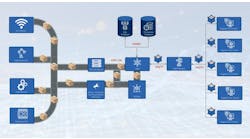The impact of OPC UA on PLCs and controls engineering
Deane Horn is director, marketing, at Softing. He shared his thoughts on open platform communications unified architecture (OPC UA), programmable logic controllers (PLCs), the edge and cloud-based computing.
What have been the most significant advancements/changes in technology that have affected OPC UA acceptance/implementation in the past five years?
Deane Horn, director, marketing, Softing: Over the past five years, several significant advancements and changes in technology have positively influenced the acceptance and implementation of open platform communications unified architecture. Historically, a lot of events have fallen into place:
• OPC first launched as an easy-to-use Ethernet and vendor-neutral connectivity protocol. That set the stage.
• OPC UA, also vendor-neutral, added encryption and security, along with a lot of other capability, but the next item would never happen without security.
• Industrial plants began to implement digital-transformation strategies that strategically integrated OT and IT, that is, integrated the factory-floor PLCs to business IT networks and server to monitor performance, efficiency, quality and a host of other process improvements like track and trace or downloading recipes. Without encryption and security, IT departments would shut this connection down.
Here are some other key developments:
• increased focus on Industry 4.0 and Internet of Things (IoT)
• advancements in encryption and security
• cloud computing and edge computing—OPC UA's scalability and support for complex data structures align well with these requirements, facilitating seamless cloud integration
• integration of machine learning (ML) and artificial intelligence (AI)—OPC UA's ability to handle extensive and complex data models makes it well-suited for AI-driven applications
• expansion in different industries—originally more focused on automation and manufacturing, OPC UA may expand into various other sectors like energy, building automation and healthcare, thanks to its versatility, robustness and security
• development of companion specifications to tailor OPC UA to specific applications—for example, strip out security for embedding OPC UA in field devices.
How has OPC UA benefitted from the proliferation of components from multiple suppliers in machinery?
Deane Horn, director, marketing, Softing: I see this has suppliers and end users benefiting. Suppliers have benefited because they can apply their expertise on products and be “in the game” simply by having an open communications protocol. Customers benefit because they can select best-in-class solutions and not be forced into a proprietary ecosystem by one vendor.
Can you explain how Industry 4.0 initiatives or the Industrial Internet of Things (IIoT) has impacted the use of OPC UA in manufacturing?
Deane Horn, director, marketing, Softing: Historically, PLCs and the plant floor were protected from business systems and software by firewalls. Industry 4.0 and IIoT have created a need to more tightly connect OT to IT, but this is dangerous without the right security. OPC UA can meet the security requirements, which becomes an enabler for Industry 4.0 and IIoT.
Do you find OPC UA more useful in small embedded systems or larger cloud-based applications?
Deane Horn, director, marketing, Softing: One answer is it is most useful in the middle. Small embedded systems like sensors and devices are normally connected to PLCs and distributed control systems (DCSs), so OPC UA is not normally needed here. Then PLCs and DCSs have the challenge of connecting to business systems and cloud applications. This middle connection, PLC-to-software/cloud is where OPC UA is most useful.
The second answer is OPC UA is more useful in cloud-based applications.
In small embedded systems:
• Resource constraints: Embedded systems often have limited processing power, memory and storage. OPC UA, being a robust and feature-rich protocol, might require more resources than some embedded systems can provide.
• Real-time requirements: Many embedded systems require real-time performance. While OPC UA supports real-time operations, the complexity of the protocol could introduce latency, which might be a critical factor for certain embedded applications.
• Scalability and flexibility: For small-scale applications, the comprehensive features of OPC UA might be underutilized, yet they offer scalability if the system needs to expand or integrate with larger networks in the future.
Larger cloud-based applications:
• Interoperability: OPC UA excels in environments where interoperability between different systems and devices is crucial. In large cloud-based applications, this interoperability facilitates seamless integration and data exchange across diverse platforms.
• Security: OPC UA provides robust security features, which are essential for cloud-based applications dealing with sensitive data and requiring secure communication.
• Complex system integration: Large applications often involve complex system integrations. OPC UA's comprehensive feature set supports complex data models and communications, making it well-suited for these environments.
In summary, while OPC UA can be more resource-intensive than some protocols traditionally used in small embedded systems, its scalability, security and interoperability features make it highly beneficial in larger, complex, cloud-based applications. However, for smaller systems with limited resources and real-time requirements, a simpler protocol might be more appropriate unless scalability and future integration with larger systems are anticipated.
How have the security and scalability of OPC UA made it more user-friendly?
Deane Horn, director, marketing, Softing: Regarding security, encryption and authentication have enabled OT to cross into IT more easily. In fact, this will challenge the entire Purdue Model since the historical layers of protection will not be required.
For scalability, I’m not sure. Although I know that OPC UA being an untraditional protocol with tons of flexibility has enabled some interesting OPC UA solutions that solve challenges of managing and maintain five to 10 or even hundreds of OPC UA sources and destinations without needing to manage each on it its own. For example, how do you manage this? OPC UA allows for solutions to be developed to manage this and keep this secure.
Tell us about one of your organization’s state-of-the-art OPC-certified products.
Deane Horn, director, marketing, Softing: DataFeed OPC Suite is an industrial connectivity software suite that connects more than 25 PLC types to OPC UA sources. For enterprise connectivity, dataFeed secure integration server (SIS) allows you to manage all your OPC sources and destinations through one central application. What’s unique about dataFeed OPC Suite is the ease of connectivity. For example, natively browse Logix tags from Allen-Bradely PLCs or natively browse symbols from Siemens PLCs, rather than complex configuration. And we always offer a 72-hour free trial to try dataFeed with your project to prove it will work for your application.






